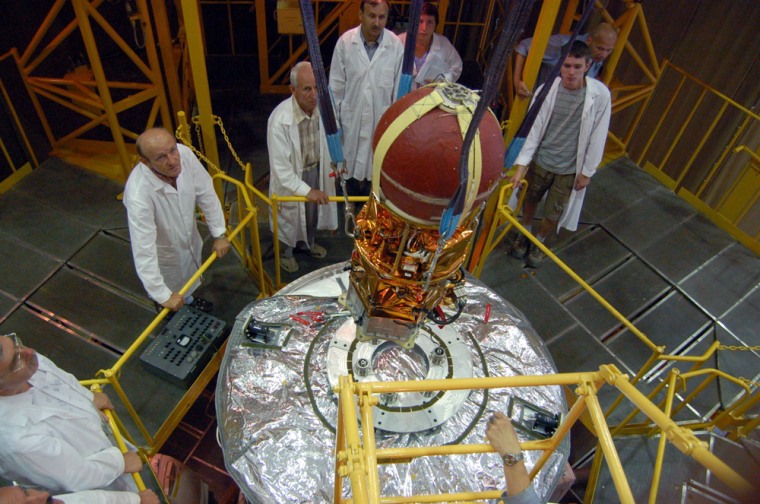Russia’s Foton science satellite will include an innovative space transportation experiment that is testing a theoretically cheaper method of returning small cargo from the international space station — and it’s been designed and developed by a team of students organized by the European Space Agency.
The approach is to use a space tether as a transportation mechanism, a concept so risky and revolutionary that existing space agencies have for years been afraid of even trying it out for fear of an embarrassing failure.
The Young Engineers Satellite 2, or YES2 for short, is piggybacking into orbit aboard a Russian science satellite named Foton-M3, due for launch at 7 a.m. ET Friday. The Foton satellite had two major advantages — some extra space for a hitchhiker, and a low orbit around Earth (about 155 miles, or 250 kilometers). As a result, the ticket was pretty cheap.
The low orbit is critical because the YES2 objective is to demonstrate the ability to fling a small landing capsule down into the atmosphere without the use of rockets at all. Instead, the tiny 12-pound (5.5-kilogram) heat-shielded sphere, nicknamed "Fotino," will be lowered from the Foton-M3 to the end of a 19-mile-long (30-kilometer-long) fishline-thin tether (the reel is called "Floyd"), and then released.
It will still be in orbit, of course. It won't just fall straight down to the ground. But it will be headed home, all the same.
Tethered space objects follow some bizarre rules of thumb: For example, suppose you have two masses that are connected by a tether of any given length, with one positioned above the other. If the tether is cut, the two masses enter new orbital paths. One gets higher, and one gets lower. These paths will still share a tangent at the orbital location where the cut occurred. But half an orbit after separation, the orbits will be seven times as far apart as when they were tethered. That factor of seven is based on theory — and it has been observed in reality when space tethers have been cut in the past.
This happens because of physics and the laws of motion. The tether-joined system was orbiting as if all the mass were concentrated at some point along the tether. Just how far along the tether depends on the relative masses of the two objects. Since the velocity required to remain in a circular orbit decreases as altitude increases, the higher of the two objects is actually going a tad faster than a single object would if it were maintaining that same altitude. The lower object, meanwhile, follows its circular path slower than a solo payload would speed along to stay at the same altitude. The tethered lower object remains at its altitude only due to a small lift force from the tug on the tether.
Cut that tether — and that is exactly what the YES2 experiment intends to do — and the lower object slips closer to Earth. How much it slips depends on how long the tether was.
Say the original separation is 30 kilometers, and the tethered system is orbiting about 250 kilometers high. This means that after separating, the smaller capsule will wind up in an orbit with a low point of 250 minus 7 times 30, or 40 kilometers (25 miles). That orbit grazes too deeply into the upper atmosphere to survive, and the payload will decelerate from air drag and then fall to Earth. This is exactly the plan for Foton’s hitchhiker.
The deployment will only take a few hours, and the 0.4-mm-thick nylon tether (19 miles of it weighs only 11 pounds) will also hit the atmosphere, to burn up. So the odds of ground observers seeing it in the sky are slim. It will pass over distant regions of Earth at dawn and dusk, the only intervals when it can be seen from the ground.
In the most famous previous case of a cut tether, on the STS-75 shuttle mission in 1995, the tethered object was above the shuttle. When the line parted, by accident, it was flung into a higher orbit, in obedience to the factor-of-seven rule of thumb. There it remained for weeks, visible to ground observers as an eerie thin line marching vertically across the dusk skies.
If all goes well for this experiment, future sighting opportunities may occur. If the concept works, it will become routine. Small tethered mail from space (failed equipment, medical specimens, high-value crystals, even personal letters) will get flung back into the atmosphere. Small science satellites will get flung into higher orbits. All the more reason to keep your eyes on this bold experiment.
James Oberg, space analyst for NBC News, spent 22 years at NASA's Johnson Space Center as a Mission Control operator and an orbital designer. His tasks for NASA included the development of shuttle crew procedures for tether deployment and retrieval.
